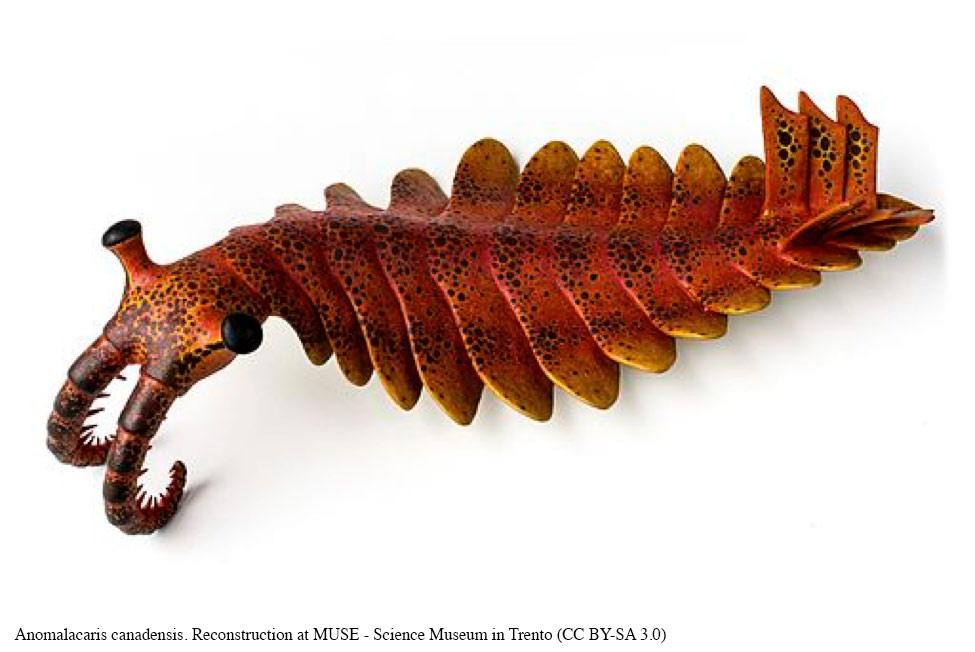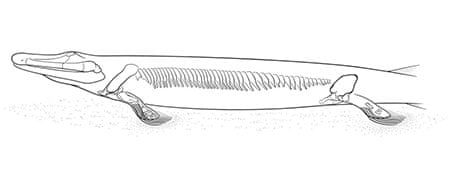Paleozoic Evolution
Callan Bentley, Karen Layou, Russ Kohrs, Shelley Jaye, Matt Affolter, and Brian Ricketts and Charlene Estrada
The beginning of the Paleozoic Era is marked by the first appearance of hard body parts like shells, spikes, teeth, and scales; and the appearance in the rock record of most animal phyla known today. Most basic animal body plans appeared in the rock record during the Cambrian Period. This sudden appearance of biological diversity is called the Cambrian Explosion. Scientists debate whether this sudden appearance is more from a rapid evolutionary diversification due to a warmer climate following the late Proterozoic glacial environments, better preservation and fossilization of hard parts, or artifacts of a more complete and recent rock record. For example, animals may have been diverse during the Ediacaran Period, setting the stage for the Cambrian Explosion. Still, they lacked hard body parts and would have left few fossils behind. Regardless, the Cambrian Period, 541-485 million years ago, marked the appearance of most animal phyla.
/https://tf-cmsv2-smithsonianmag-media.s3.amazonaws.com/filer/Cambian-Period-Burgess-Shale-520.jpg)
One of the best fossil sites for the Cambrian Explosion was discovered in 1909 by Charles Walcott (1850-1927) in the Burgess Shale formation in western Canada. The Burgess Shale is a Lagerstätte (LAGER-STAT-EH), a site of exceptional fossil preservation that includes impressions of soft body parts. This discovery allowed scientists to study Cambrian animals in immense detail because soft body parts are not normally preserved and fossilized.
Other Lagerstätte sites of similar age in China and Utah have allowed scientists to form a detailed picture of Cambrian biodiversity. The biggest mystery surrounds animals that do not fit existing lineages and are unique to that time. This includes many famous fossilized creatures: the first compound-eyed trilobites; Wiwaxia, a creature covered in spiny plates; Hallucigenia, a walking worm with spikes; Opabinia, a five-eyed arthropod with a grappling claw; and Anomalocaris, the alpha predator of its time, complete with grasping appendages and circular mouth with sharp plates. Most notably appearing during the Cambrian is an important ancestor to humans. A segmented worm called Pikaia is thought to be the earliest ancestor of the Chordata phylum that includes vertebrates and animals with backbones. The Chordata phylum contains all animals with spines, including humans!

By the end of the Cambrian, mollusks, brachiopods, nautiloids, gastropods, graptolites, echinoderms, and trilobites covered the sea floor. Although most animal phyla appeared by the Cambrian, the biodiversity at the family, genus, and species level were low until the Ordovician Period. During the Great Ordovician Biodiversification Event, vertebrates and invertebrates (animals without a backbone) became more diverse and complex at the family, genus, and species levels.
The cause of the rapid speciation event is still debated. Still, some likely causes are a combination of warm temperatures, expansive continental shelves near the equator, and more volcanism along the mid-ocean ridges. Some have shown evidence that an asteroid breakup event and consequent heavy meteorite impacts correlate with this diversification event. The additional volcanism added nutrients to ocean water, helping support a robust ecosystem. Many life forms and ecosystems that would be recognizable in current times appeared at this time. Mollusks, corals, and arthropods, in particular, multiplied to dominate the oceans.
One important evolutionary advancement during the Ordovician Period was reef-building organisms, mostly colonial coral. Corals took advantage of the ocean chemistry, using calcite to build large structures that resembled modern reefs like the Great Barrier Reef off the coast of Australia. These reefs housed thriving ecosystems of organisms that swam around, hid in, and crawled over them. Reefs are important to paleontologists because of their preservation potential, massive size, and in-place ecosystems. Few other fossils offer more diversity and complexity than reef assemblages.
Ordovician Mass Extincition
According to evidence from glacial deposits, a small ice age caused sea levels to drop and led to major mass extinction by the end of the Ordovician. This is the earliest of five mass extinction events documented in the fossil record. During this mass extinction, an unusually large number of species abruptly disappear in the fossil record (see video).
Life bounced back during the Silurian period. The major evolutionary event was the development of the forward pair of gill arches into jaws, allowing fish new feeding strategies and opening up new ecological niches. This period also included the start of armored fishes, known as the placoderms. In addition to fish and jaws, Silurian rocks provide the first evidence of terrestrial or land-dwelling plants and animals. The first vascular plant, Cooksonia, had woody tissues, pores for gas exchange, and veins for water and food transport. Insects, spiders, scorpions, and crustaceans began to inhabit moist, freshwater terrestrial environments.
The Devonian Period is called the “Age of Fishes” due to the rise in plated, jawed, and lobe-finned fishes. The lobe-finned fishes, which were related to the modern lungfish and coelacanth, are important for their eventual evolution into tetrapods, four-limbed vertebrate animals that can walk on land. The first lobe-finned land-walking fish, named Tiktaalik, appeared about 385 million years ago and served as a transitional fossil between fish and early tetrapods. Though Tiktaalik was a fish, it also had some tetrapod structures.

Several fossils from the Devonian are more tetrapod-like than fish, but these weren’t fully terrestrial. The first fully terrestrial tetrapod arrived in the Mississippian (early Carboniferous) period. By the Mississippian (early Carboniferous) period, tetrapods had evolved from a common tetrapod ancestor into two main groups, amphibians, and amniotes. The amphibians could breathe air and live on land but still needed water to nurture their soft eggs. The first reptile (an amniote) could live and reproduce entirely on land with hard-shelled eggs that wouldn’t dry out.

Land plants had also evolved into the first trees and forests. Toward the end of the Devonian, another mass extinction event occurred. This extinction, while severe, is the least temporally defined, with wide variations in the timing of the event or events. Reef-building organisms were the hardest hit, leading to dramatic changes in marine ecosystems.
The next period called the Carboniferous (North American geologists have subdivided this into the Mississippian and Pennsylvanian periods), saw the highest levels of oxygen ever known, with forests (e.g., ferns, club mosses) and swamps dominating the landscape. This helped cause the largest arthropods ever, like the millipede Arthropleura, at 2.5 meters (6.4 feet) long!

It also saw the rise of a new group of animals, the reptiles. The evolutionary advantage reptiles have over amphibians is the amniote egg (egg with a protective shell, i.e., think chicken eggs), which allows them to rely on non-aquatic environments for reproduction. This widened the terrestrial reach of reptiles compared to amphibians. This booming life, especially plant life, created cooling temperatures as carbon dioxide was removed from the atmosphere. By the middle Carboniferous, these cooler temperatures led to an ice age (called the Karoo Glaciation) and less-productive forests. The reptiles fared much better than the amphibians, leading to their diversification. This glacial event lasted into the early Permian.

By the Permian, with Pangea assembled, the supercontinent led to a dryer climate and even more diversification and domination by the reptiles. The groups that developed in this warm climate eventually radiated into dinosaurs. Another group, known as the synapsids, eventually evolved into mammals. Synapsids, including the famous sail-backed Dimetrodon, are commonly confused with dinosaurs. Pelycosaurs (of the Pennsylvanian to early Permian like Dimetrodon, above) are the first group of synapsids exhibiting mammalian characteristics such as well-differentiated dentition incisors, highly developed canines in lower and upper jaws and cheek teeth, premolars and molars. Starting in the late Permian, the second group of synapsids, called the therapsids (or mammal-like reptiles) evolve, and became the ancestors of mammals.

